The wonderful, tough world of morel pickers
Check out our PHOTO GALLERY of Canada’s boreal forests, plus our MOREL RECIPES
Simon Hayter
Share

Each summer hundreds of nomadic pickers prowl Canada’s boreal forests in search of the elusive morel, reports Andrew Sniderman. Click here for a stunning photo gallery of morel hunters at work from Simon Hayter and here for a couple of delicious morel recipes.
“Freedom and adventure. Those are the main draws for people. You live in a tent in the bush, wake up when you want, work as hard as you want. Nobody is looking over your shoulder,” Eric Whitehead says. The 34-year-old picks, buys and distributes mushrooms—specifically, the prized morel mushroom, which looks like a cone-shaped sponge, delights gourmands, and retails for more than $100 per dried pound. “But,” he adds, “we still joke that we are slaves to the spore, moving it around the globe, doing its bidding.”
On a decent day, morel pickers make $250 by filling a pack and selling to a local buyer. Whitehead is a pro with 13 years of experience, so he can push $400.
Earlier this summer, mostly in remote parts of British Columbia, the Yukon, Alberta and the Northwest Territories, many hundreds of nomadic commercial pickers prowled boreal forests hunting morels. Unlike Canada’s tree planters, who sweat under the thumb of gargantuan logging companies, morel pickers live beyond the corporate gaze. Businesses haven’t figured out how to effectively cultivate morels, which means pickers can be as wild as their mushrooms.
Commercial picking only began in earnest in the 1980s as North Americans’ taste buds began appreciating wild mushrooms. European demand also grew when their own supply of wild mushrooms decreased because of nitrogen pollution from power plants and concerns about the widespread nuclear fallout from the 1986 Chernobyl disaster.
There are certainly easier ways to make money. Exhaustion is assured; success is unpredictable. Pickers often wander far, half-marathon far, with dreams of loading 80 lb. of mushrooms on their backs. A stoop and a pocket knife swoop sends a mushroom on its way to a hand-held bucket, which then feeds a backpack. Of course, many pickers return from an exhausting day among pitiless mosquitoes with light loads. Morel mushrooms are valuable precisely because “they are hard to find and they won’t always be there,” Whitehead says. “This is educated gambling to gather a powerful culinary experience that only a pristine forest can provide.”
Picking is typically a solitary activity for the more intense and money-driven. Keeping a mobile group united in a forest can be distracting. The mushroom we eat is the fruit—that is, the reproductive organ—of a larger organism living underground in complex interdependence with tree roots and the soil. “You have to be quiet and focused,” Whitehead explains. “When you are in the zone, it’s almost like you are letting the mushrooms speak to you. You become really aware of trends and where the morels are growing.”
Being in the bush also means being among bears. Visibility in a forest is limited. In 2004, Whitehead emptied a full can of bear spray on an unannounced and hulking visitor. The black bear ambled within a mere one and a half metres of him. Whitehead held his ground, more from wisdom than courage. “The bear gave me a look, like f–k you, then walked off.”
Whitehead’s Vancouver-based company, Untamed Feast, sold $140,000 worth of tasty fungus last year to Canadians, but mostly the cash crop gets exported to European restaurants. Chefs rave about the morel. Bill Jones of Deerholme Farm in B.C. positively swoons over the morel’s “affinity with a cream sauce,” plus Jones likes that the flavour “doesn’t hit you over the head like pine or porcini mushrooms.” Chef Jonathan Gushue of Langdon Hall in Toronto says the morel “is one of those very rare products in the food world that you can really just serve—fry with butter and serve. It’s meaty, with great texture.” Fresh morels last mere days, so they are usually dried shortly after picking and resurrected in a faraway kitchen.
No one quite knows exactly why, but bumper crops of morels appear the year after forest fires like delectable phoenixes rising from the ashes. Every year the government of Yukon releases a detailed report on the thousands of hectares scorched by wildfires; prospective pickers scour it like a treasure map. Last year, a lightning fire torched 35,000 hectares of boreal forest around Watson Lake, some 450 km east of Whitehorse. Predictably, hundreds of pickers set up shop in the burn zone for morel season, which typically spans June in northern Canada.
By early July, “Butch” and his crew of six are among the last remaining pickers in this area, hundreds of kilometres from the area near Yellowknife where Whitehead and his team foraged. Butch, the crew’s elder statesman at 40, has been picking for 18 years. His team sees itself as the hard core among hordes of hippie lifestylers. They camp at the dead end of a service road beside a battered red Rolling Stones flag, marked with a scrawled “B S” (for Butch and his wife, Shirley). Out here, cellphones go blank; Internet is out of the question. A derelict pickup truck with a miraculous battery serves as a radio, serenading the group with heavy metal. Gusts of wind bring the unwelcome odour of socks hanging nearby on soot-blackened branches. A month of empty beer cans perpetually fails to make a pyramid.
This season has been a tough one—at this late stage, each of them can only manage about $200 worth of morels a day—but Butch and company continue to roam the forest of blackened spires, acquiring the ash-black clothes and skin of coal miners. Above, where there was foliage, there is sky. The air is dry and acrid with the smell of burnt trees. Everything, even tongues, acquires a film of dust, courtesy of gravel roads and ubiquitous ash. Butch succinctly summarized the principal virtue of picking: “No bosses.” Whatever each person picks they keep.
Whereas Whitehead always uses a GPS, this crew opts for a compass and photocopied, unlaminated map printouts. They make the uncommon decision to roam as a team, kept together by steady shouts of “Yo.” Most carry seven- to 10-inch knives on their hips—supposedly to fight bears, not cut mushrooms. One said he would carry a gun, but a spotty record meant he couldn’t manage the permit.
It is hard to imagine a cocktail party of morel pickers and morel consumers going swimmingly. The livelihood of the gritty pickers depends on the palates of the urban wealthy. A single pine-cone-sized mushroom at Loblaws goes for about three dollars these days. Sometimes the only mushrooms a picker can afford to eat are the ones they pick. In a bad year like this one, the best that some can hope for is covering their expenses.
Dylan Gordon, a doctoral student at the University of Toronto, studies wild food and the people who forage for it. He has spent much of the past two years in blackened forests among pickers and their prey. “This is one of the few remaining ways someone can live off the land without a lot of capital. The industry is so small and fickle that big industrial forces aren’t very interested.” With declining fish stocks and the mechanization of logging, Gordon sees morel picking as “part of a shrinking patchwork of occupations for those struggling to support small-scale rural livelihoods. And you can see mushroom picking as a saga of urban and rural Canada, with radically different ways of living.”
Morel picking is a trade, but it is also a lifestyle. Many older couples see it as a form of self-sustaining camping, and pickers of all ages revel in the purity of picking. Lance Staples, a 24-year-old botanist, joined Whitehead this year for his first ever morel hunt. He made his way from Victoria to Great Slave Lake, about 20 km south-east of Yellowknife. He only managed to grind out $100-$150 on good days, despite his karmic contribution for “feeding the bugs.” Still, he would do it again. “It’s the essence of being human, you know, foraging for food in the forest,” he says. “And somehow, miraculously, I’m getting paid for it. I walk around the forest all day, immersed in nature, escaping the stresses of daily living.” Staples plans to head for a burn site in Idaho, where he hopes his financial luck will change.
Tim Poulin, a gangly 22-year-old with shaggy black hair from near Smithers, B.C., joined forces with Butch five years ago. He had wanted an outdoor job, so Butch brought him to the morels. This year Poulin persuaded three teenage friends to join the crew. On this day in the Yukon, Poulin had already walked 20 km and still had a ways back to camp. He sat on the charcoal ground for lunch, savouring sips of Gatorade from a battered water bottle and sharing a box of Triscuits with two mates. He surveyed the desolate landscape, which had all the charm of a picturesque war zone, and said, “This is the best office in the world.”
**
MOREL PICKERS, A PHOTO GALLERY
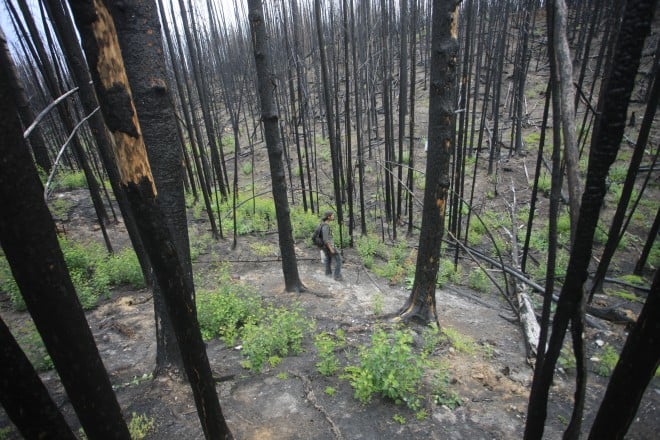


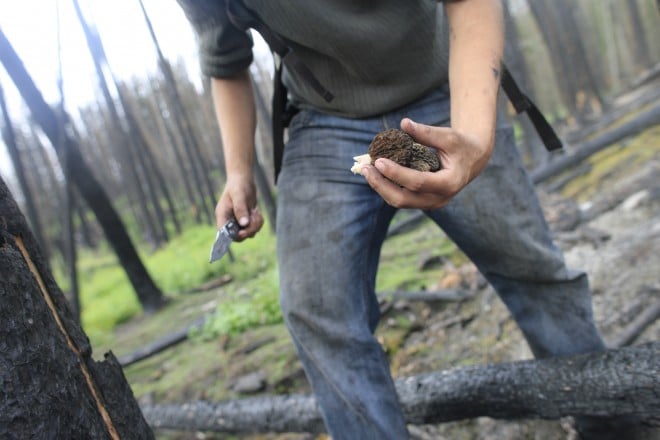
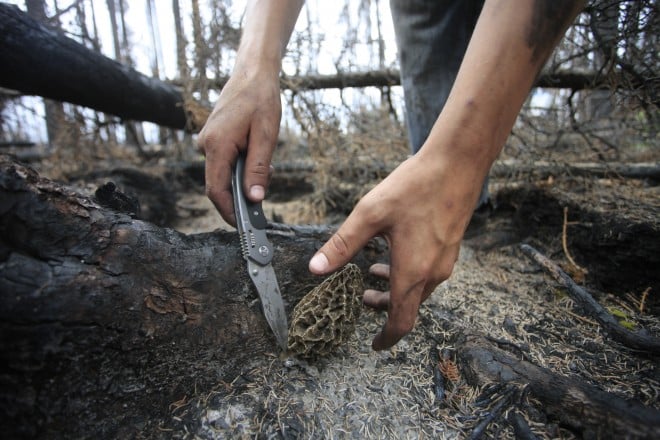

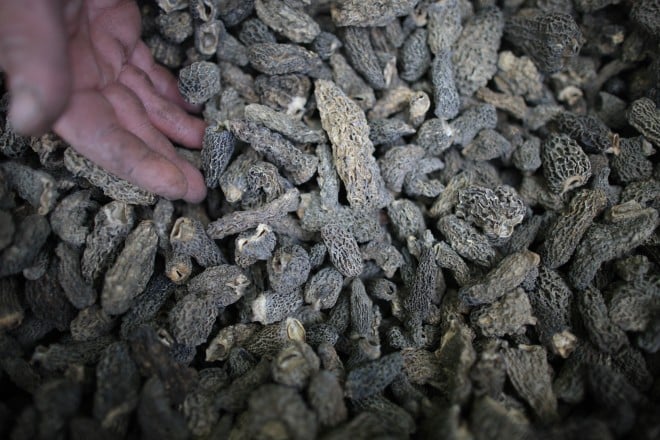
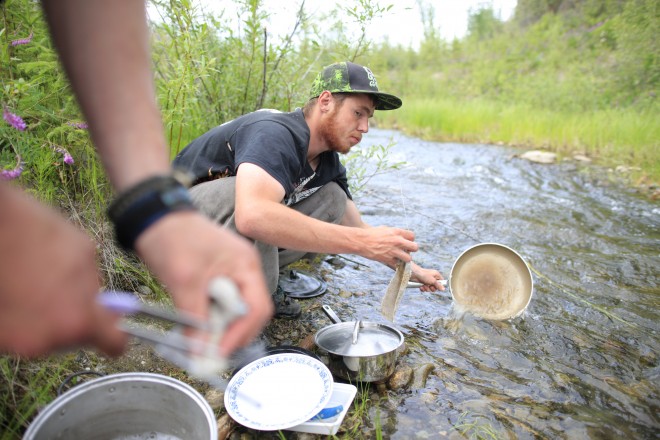
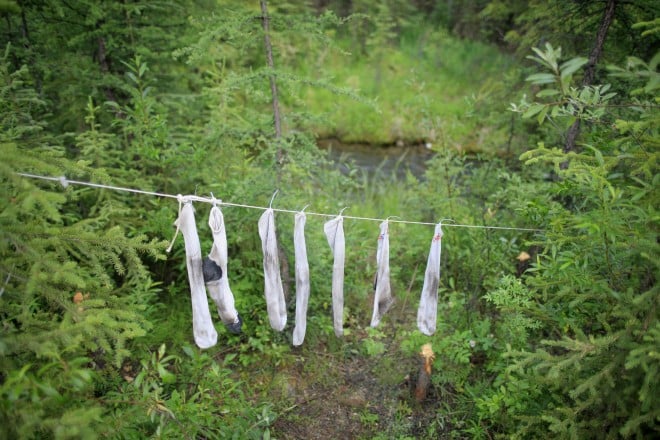
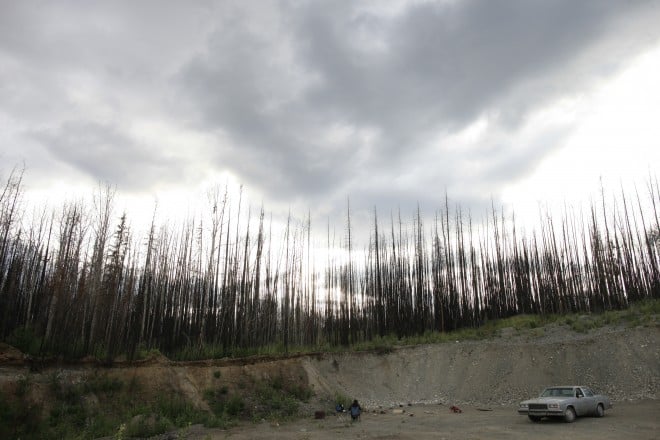
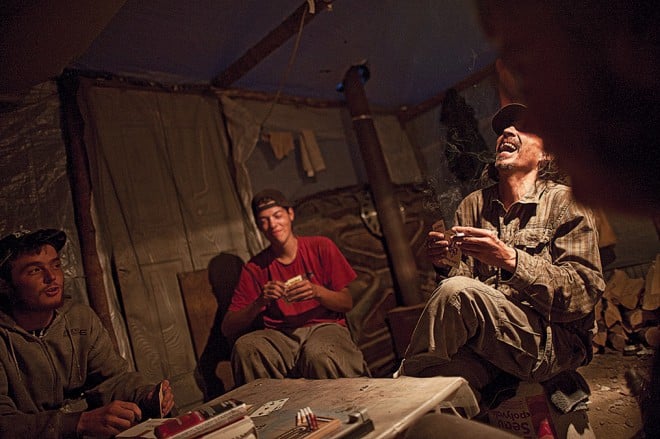
**
NEVER TASTED MORELS? TRY THESE RECIPES:
http://www.scribd.com/doc/102489336